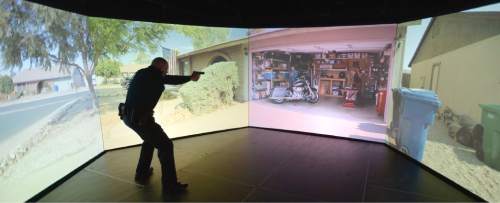This is an archived article that was published on sltrib.com in 2016, and information in the article may be outdated. It is provided only for personal research purposes and may not be reprinted.
Provo • A man holding an infant over a bridge. A suspect wielding a knife in the park. A woman holding a syringe.
These are just some of the scenarios that Utah County police officers face in a new training simulator.
During a media event Monday, Provo police showed off the device, designed to help protect officers and to help police protect the public. The VIRTRA 300 was funded with $375,000 from the Legislature.
Rep. Keven Stratton, R-Orem, said the money will help protect the heroes who protect residents on a regular basis, as well as the public at large.
"This is a real win for us in the community," Stratton said. He said the training would help protect the officers and the public. The training is aimed at helping officers defuse situations without using lethal force.
"De-escalation is always the goal, but sometimes that's not possible," said Provo Police Lt. Brandon Post.
The officer stands in the center of the system surrounded by five walls with changing situations appearing on the screen requiring the officer to interact with virtual suspects or bystanders. The officer is equipped with pepper spray, an unloaded firearm, and a Taser. Whatever weapon the officer uses, the system will react accordingly. If the officer makes a mistake and a suspect shoots, the trainee will feel the jolt of a Taser device, simulating a shot.
The best thing about the system is that each scenario has different paths, meaning the training officer can change the virtual suspect reaction to keep the element of surprise, said Post. For instance, the trainer could have the suspect surrender or pull a gun. New scenarios are added to the VIRTRA 300 on an ongoing basis.
While not used as firearm training, the system can also show where the bullets would strike.
Det. Daniel Pust took part in a scenario where a man pulled a gun in what was called in as a simple noise complaint. Just as on the street, an officer never knows what's going to happen, even on simple calls. Pust said he has run multiple scenarios and the practice is helpful in guiding how he interacts with residents on a day-to-day basis.
After Pust gave a demonstration, the VIRTRA 300 was opened to members of the media who wanted to try their hand at law enforcement. Stratton, the lawmaker, also gave it a shot, successfully de-escalating a scenario.
The simulator is housed at an abandoned church owned by Nu-Skin, but made available for use by police. Police Chief John King says the VIRTRA 300 is a region-wide tool and all police agencies in Utah County have access to it.
"That's part of the reason state lawmakers went for it, it was region wide," King said.
In Utah County, the plan is for every officer to run through the training twice a year, said Post.









